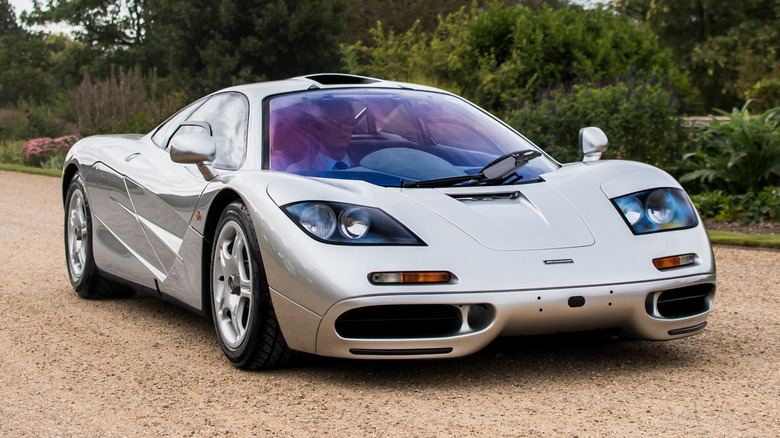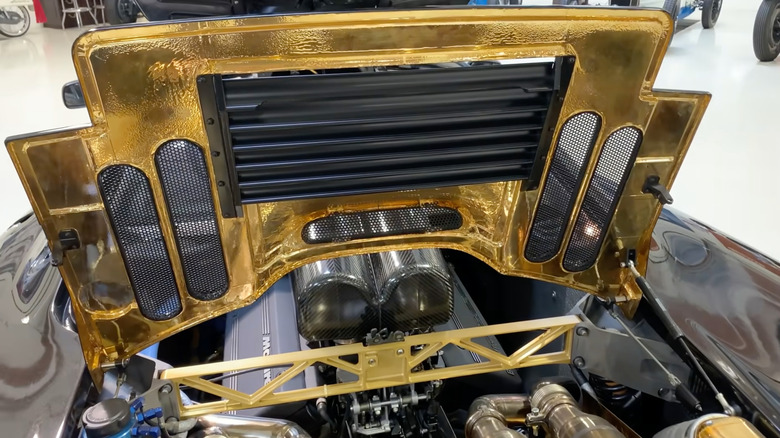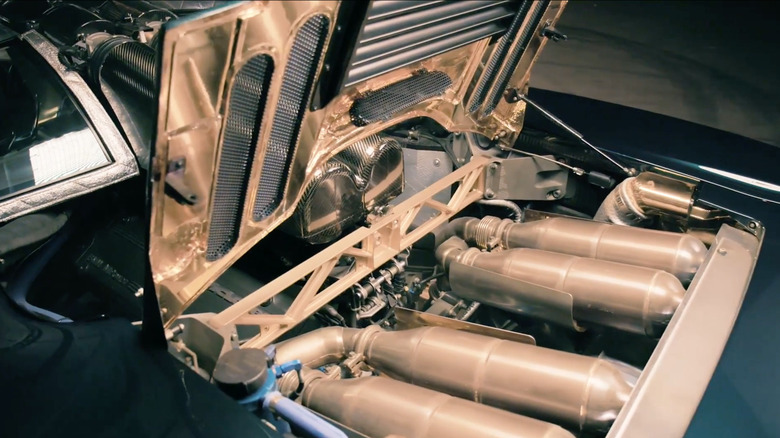The McLaren F1 Used Real Gold In Its Engine: Here's Why
The world of F1 is considered the pinnacle of automobile engineering. After all, milliseconds decide who gets to spray champagne on the podium, and every single aspect of the car must be tuned to extract the maximum performance out of it. And if that means using something as expensive as gold under the hood, it's all fair game. And guess what? McLaren actually went ahead with the pricey adventure on its MCL35 race car.
"When it shines like gold, you'll remember me." But before the racing machine was burning rubber on asphalt, McLaren made waves by using pure gold to cool down the legendary F1 sports car. Yes, that's the starting line of an article posted on the official McLaren website, just to set the tone. McLaren's fancy for gold was not all show, however. Kristen Lee at SlashGear's sister site, Jalopnik, was able to snag pictures of a gold foil-lined engine bay on a McLaren F1, where the precious material was used as a heat reflector.
Just to clear things up, McLaren didn't go with gold to drum up hype, but there was material science behind the decision. Steve Foster, a Principal Composites Engineer in the McLaren F1 team, revealed that gold is used in various forms (and locations) on their speed demons to cool things down. "It's used to reflect infrared rays," Foster explained while talking about the MCL35, which made its debut decades after the F1 as McLaren's championship chaser with Lando Norris and Carlos Sainz behind the wheels.
Precious metal in precious places
You must be wondering just how much gold is needed to assist with cooling down the engine assembly? Well, not much, actually. Each McLaren F1 unit used 16 grams of pure gold foil to line the entire engine bay. As per the latest J.P. Morgan estimates, the price of gold is currently hovering around $3,400 per ounce in the U.S. market. By those estimates, you are looking at roughly $1,900 worth of gold in each F1 sports car.
The gold investment is minuscule compared to the car's cost back in the 1990s, when the sticker price of a McLaren hovered between $0.8 and $1 million. And if you're trying to do the math by today's standards, don't even bother. The McLaren F1 is one of the most highly coveted cars on the planet. In 2021, one lucky buyer snagged a unit up for auction at Pebble Beach in California for a cool $20.5 million. In 2015, a twice-wrecked F1 owned by comedian and actor Rowan Atkinson was sold for over $12 million.
It's not clear just how much that pure gold helped the naturally aspirated 6.1-liter, V12 engine roaring inside the car, but the F1 certainly managed to break a few records. McLaren, however, maintains that pure gold was the "best heat reflector available" at the time. It was the fastest road-legal car at the time, and heavily borrowed from the tech stack on Formula 1 cars.
Blazing a path, from roads to races
The McLaren F1 was ahead of its time in many respects, and its usage of gold for heat management was no less pioneering. McLaren is currently using 22-karat gold on their MCL35 race car as a heat shielding material due to its reflective properties. "We use it to protect certain parts of the car from heat damage," it says. You see, the engine of an F1 car generates a lot of heat. According to McLaren, gases expelled from the exhaust of an F1 car can reach a peak temperature of 1,832 degrees Fahrenheit.
That's more than enough to melt aluminum. The rest of the parts run no less hot. The disc brakes can also reach the same temperature mark, 20% higher than their peak best-performing range. In a nutshell, the F1 cars need everything technically possible to either divert or regulate the immense heat generated by them as they cruise and corner at breathtakingly high speeds. So, how does gold fit into the picture?
GOLD?! On an @F1 car? 🤩 pic.twitter.com/GHiPxODM26
— McLaren (@McLarenF1) June 14, 2023
According to McLaren, the gold sheet diverts the heat away from the fuel tanks and keeps it at an optimal temperature. Additionally, it also assists with keeping things from getting toasty inside the cockpit. McLaren is also using gold in the brake assembly, which also gets notoriously hot. "You'll find that some parts of the brake ducting on the MCL35 have a sandwich construction, consisting of a layer of gold foil, silica-based aerogel and carbon fibre," explains McLaren's Foster.


